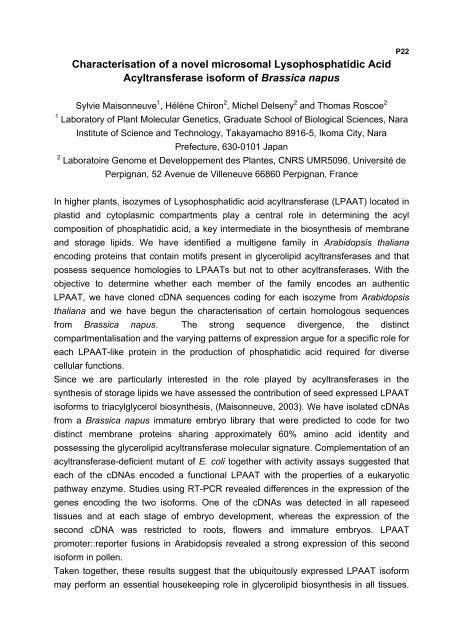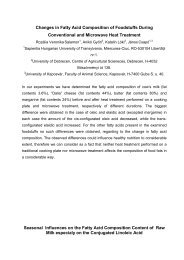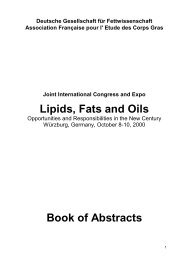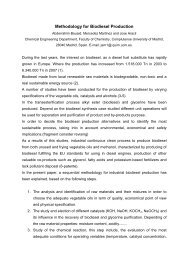Abstracts now available online - Euro Fed Lipid
Abstracts now available online - Euro Fed Lipid
Abstracts now available online - Euro Fed Lipid
Create successful ePaper yourself
Turn your PDF publications into a flip-book with our unique Google optimized e-Paper software.
Characterisation of a novel microsomal Lysophosphatidic Acid<br />
Acyltransferase isoform of Brassica napus<br />
Sylvie Maisonneuve 1 , Hélène Chiron 2 , Michel Delseny 2 and Thomas Roscoe 2<br />
1<br />
Laboratory of Plant Molecular Genetics, Graduate School of Biological Sciences, Nara<br />
Institute of Science and Technology, Takayamacho 8916-5, Ikoma City, Nara<br />
Prefecture, 630-0101 Japan<br />
2<br />
Laboratoire Genome et Developpement des Plantes, CNRS UMR5096, Université de<br />
Perpignan, 52 Avenue de Villeneuve 66860 Perpignan, France<br />
In higher plants, isozymes of Lysophosphatidic acid acyltransferase (LPAAT) located in<br />
plastid and cytoplasmic compartments play a central role in determining the acyl<br />
composition of phosphatidic acid, a key intermediate in the biosynthesis of membrane<br />
and storage lipids. We have identified a multigene family in Arabidopsis thaliana<br />
encoding proteins that contain motifs present in glycerolipid acyltransferases and that<br />
possess sequence homologies to LPAATs but not to other acyltransferases. With the<br />
objective to determine whether each member of the family encodes an authentic<br />
LPAAT, we have cloned cDNA sequences coding for each isozyme from Arabidopsis<br />
thaliana and we have begun the characterisation of certain homologous sequences<br />
from Brassica napus. The strong sequence divergence, the distinct<br />
compartmentalisation and the varying patterns of expression argue for a specific role for<br />
each LPAAT-like protein in the production of phosphatidic acid required for diverse<br />
cellular functions.<br />
Since we are particularly interested in the role played by acyltransferases in the<br />
synthesis of storage lipids we have assessed the contribution of seed expressed LPAAT<br />
isoforms to triacylglycerol biosynthesis, (Maisonneuve, 2003). We have isolated cDNAs<br />
from a Brassica napus immature embryo library that were predicted to code for two<br />
distinct membrane proteins sharing approximately 60% amino acid identity and<br />
possessing the glycerolipid acyltransferase molecular signature. Complementation of an<br />
acyltransferase-deficient mutant of E. coli together with activity assays suggested that<br />
each of the cDNAs encoded a functional LPAAT with the properties of a eukaryotic<br />
pathway enzyme. Studies using RT-PCR revealed differences in the expression of the<br />
genes encoding the two isoforms. One of the cDNAs was detected in all rapeseed<br />
tissues and at each stage of embryo development, whereas the expression of the<br />
second cDNA was restricted to roots, flowers and immature embryos. LPAAT<br />
promoter::reporter fusions in Arabidopsis revealed a strong expression of this second<br />
isoform in pollen.<br />
Taken together, these results suggest that the ubiquitously expressed LPAAT isoform<br />
may perform an essential housekeeping role in glycerolipid biosynthesis in all tissues.<br />
P22
















